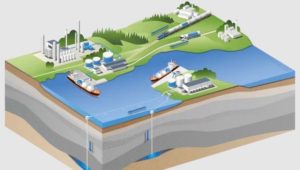The CinfraCap project, which is focused on finding an optimised infrastructure for transporting liquid carbon dioxide from plant to quayside, is one of the three climate-smart projects to have made it through to the final round of the IAPH 2021 Sustainability Awards.
The ports of the world have joined forces in a sustainability programme of which the IAPH 2021Sustainability Awards is an integral part. From an initial list of 64 sustainability projects, the jury has named the three finalists. The CinfraCap project is competing in the Climate & Energy category.
“The fact that CinfraCap has been selected is a major achievement for us and an honour for everyone concerned. CinfraCap is an important part of a wide-ranging programme aimed at making the port fossil free. If we can produce a good business model, CinfraCap will be of crucial significance in the task of reducing carbon emissions, not only in Sweden but throughout the world. We have our fingers crossed that CinfraCap will emerge the winner in this major international competition,” said Edvard Molitor, Head of Sustainability at the Gothenburg Port Authority.
IAPH (International Association of Ports and Harbors) is the world’s largest trade organization and cooperation body for international ports with over 200 member ports in 90 countries worldwide. The head office is located in Tokyo and the organization has advisory functions to, among others, several UN agencies.
Factfile: CinfraCap
CCS, Carbon Capture and Storage, is widely regarded as a key component in the transition of the global energy system, and several research and development projects are already under way. The various parties within the CinfraCap project are looking to join forces to identify the most effective way of approaching the industry-scale logistics required to support CCS. The idea is to present concrete proposals for an optimised infrastructure, and link into other CCS projects. Once the infrastructure is in place, the aim is for it to be an open access system, expanding its potential user base.CinfraCap will complement a number of other ongoing research and development projects, including the Climate Smart Industry initiative, Preem CCS, ZEROC, and NorthernLights, which is a full-scale carbon capture and storage project being run off the west coast of Norway.
CinfraCap is a collaborative project between Nordion Energi, Göteborg Energi, Renova, the Gothenburg Port, Preem, and St1.
Read more about CinfraCap here
https://www.portofgothenburg.com/the-project-of-the-port/cinfracap/
Fact file: CCS
Carbon Capture Storage, CCS, involves trapping carbon and liquefying it under pressure and at low temperature. It can then be safely stored deep underground, in many cases below the seabed, reducing emissions of greenhouse gases into the atmosphere. If the carbon dioxide is captured from a biogenic source, known as a BECCS, the proportion of carbon dioxide emitted into the atmosphere can be reduced.
Illustration
- Carbon dioxide capture facility.
- Liquid carbon dioxide is transported via pipelines from capture plants nearby and by road or rail from plants further away.
- CinfraCap reception site with temporary storage at the Port of Gothenburg.
- Liquid carbon dioxide is loaded onto a ship using a loading arm.
- Receiving terminal where liquid carbon dioxide is discharged and pumped into rock formations 3,000 metres below the seabed.
- Porous rock, with impermeable rock above, where liquid carbon dioxide is returned.
Sustainability programme for the ports of the world
In 2017, the International Association of Ports and Harbours decided to set up a World Ports Sustainability Programme. Guided by the UN’s 17 sustainable development goals, the programme aims to enhance and coordinate future sustainability efforts at ports worldwide and foster international collaboration with partners in the supply chain. The World Ports Sustainability Programme, established by the IAPH back in 2008, is based on the World Ports Climate Initiative, which is now being expanded to include other sustainability areas.
The following are registered as strategic partners of the World Ports Sustainability Programme:
American Association of Port Authorities (AAPA)
European Sea Ports Organisation (ESPO)
International Association of Cities and Ports (AIVP) and
World Association for Waterborne Transport Infrastructure (PIANC)
Fact file: Port of Gothenburg
The Port of Gothenburg is the largest port in the Nordic region. 30 per cent of Swedish foreign trade passes through the Port of Gothenburg as well as half of all container traffic.
The Port of Gothenburg is the only port in Sweden with the capacity to receive the world’s largest container vessels and has the broadest range of shipping routes within and outside Europe. The 25 rail shuttles that depart each day mean that companies throughout Sweden and Norway have a direct, environmentally smart link to the largest port in the Nordic region. The Port of Gothenburg has terminals for oil, cars, ro-ro, containers and passengers.








